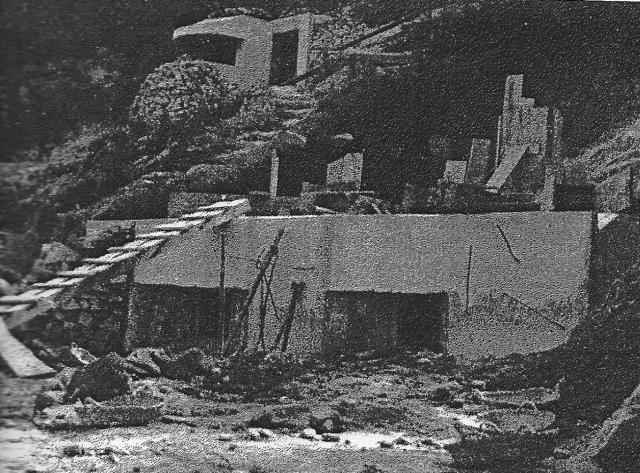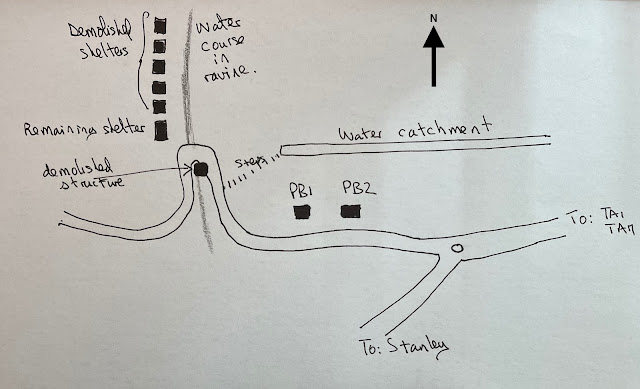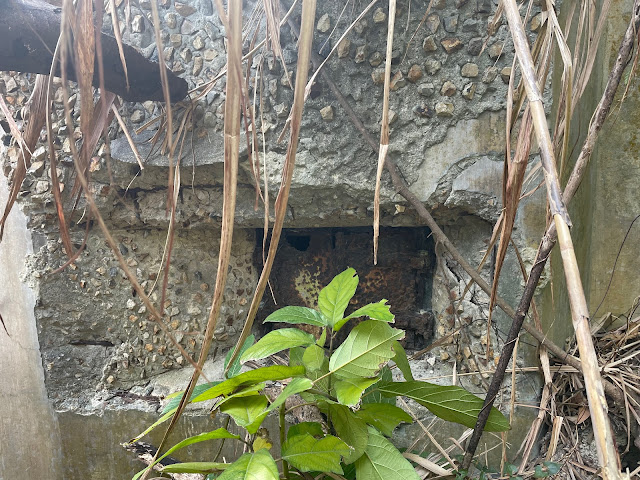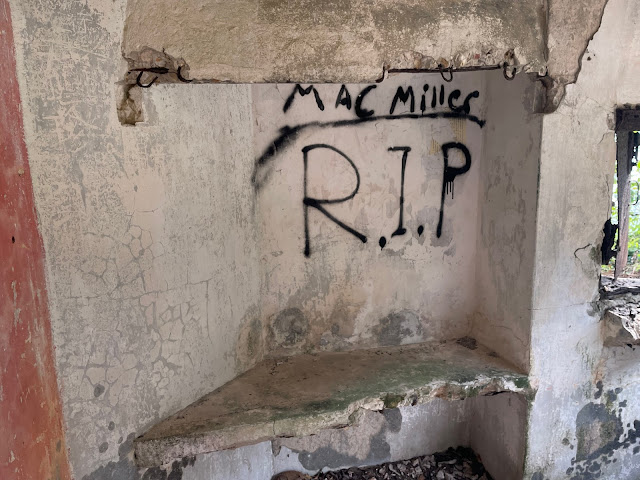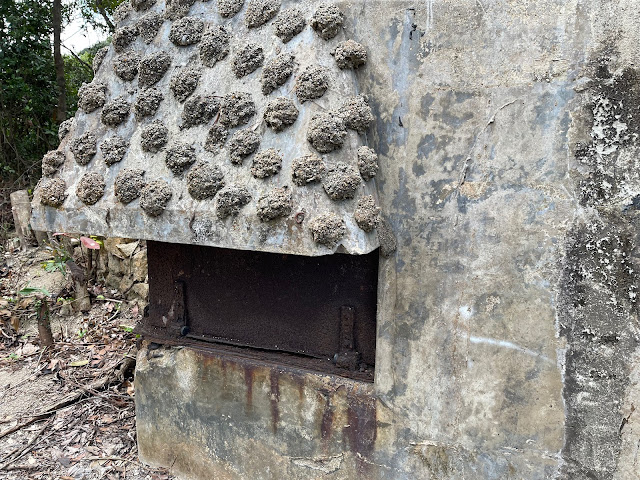On the night of the 18 December 1941, three Japanese infantry regiments landed on the northeast shore of Hong Kong Island. Each regiment deployed two of its three battalions. One battalion in each regiment being held back to be used under divisional command. A Japanese infantry battalion consisted of approximately 1,000 men. In addition to the infantry battalions there was artillery, gendarmes, engineers and other units being landed during the course of the night. One can reasonably assume that some eight thousand Japanese troops got ashore that night of which six thousand were frontline infantry. During the night, and during the course of the following morning, the bulk of this force converged from different directions on Wong Nai Chung (WNC) Gap.
Broad direction of Japanese advance following landings on the north shore
The Japanese overran the defenders on this section of the north shore. The ratio of the invader to the defender was greater than ten to one. There were 8,000 invaders and no more than 700 to 800 defenders (see calculation below).
The Defenders:
The British deployed one infantry battalion, the 5th Battalion 7th Rajput Regiment to defend this 5 kilometre stretch of the shoreline between North Point and Shau Kei Wan. The battalion deployed three companies, 'D' Coy (Capt. Newton) at North Point, 'A' Coy (Capt. Ansari) at Shau Kei Wan and 'C' Coy and HQ Coy at or around Tai Koo. The battalion commander Lt-Col Cadogan-Rawlinson had his battalion HQ located at Tai Koo Police Station. He had one company, 'B' Coy (Captain Course) in reserve at Tai Hang. The defenders included:
Three companies of Rajputs and Bn HQ (estimate 450)
Hughes Group at North Point Power Station (estimate 40)
Pak Sha Wan coastal Defence Battery (estimate 40)
'C' Coy Royal Rifles of Canada at Lye Mun Gap (estimate 120)
Sai Wan AA Fort (estimate 40)
Sai Wan 6-inch Howitzer Section (40)
Lye Mun Barracks 3.75-inch Howitzer Section (10)
Middlesex Flying Platoon survivors at HKE power station (10)
Estimate: 750
The Defence of the hills inland from the landing area
(1) At Wong Nei Chung Gap and Stanley Gap:
No. 3 Coy HKVDC manning PBs 1 and 2 and section posts including JLO 1, 2 and 3 and various roadblocks. Major Evan Stewart had established his Coy HQ in a splinter proof shelter under AA battery. (Estimated Coy strength 120)
Stanley Gap 3.7-inch AA battery. Two AA guns. (estimate 60)
Stanley Gap 3.7-inch howitzer battery. Three guns. (estimate 70)
'D' Coy Winnipeg Grenadiers close to WNC Gap with splinter proof shelters located between WNC Gap Road and the upper section of Blue Pool Road. At that time Blue Pool Road extended from Tai Hang Road to WNC Gap. (estimate 120)
No 1 Platoon No 1 Coy HKVDC at Quarry Gap (aka Sanatorium Gap) and at PB 45 on Mt Parker Road (north side the gap). (estimate 30)
Estimate: 400
(2) Reinforcements sent up into the hills on the night of the Japanese landings
Lt Birkett's platoon (from HQ Coy) were sent in two trucks from Winnipeg Grenadiers HQ at Wan Chai Gap. Burkett in one truck and his Platoon Sgt, Tom Marsh, in the second truck. (estimate 30)
Lt French's platoon (from HQ Coy) (estimate 30)
Major Gresham's 'A' Coy (estimate 120)
Estimate: 180
Taking all the estimates, for the north shore, Stanley Gap, WNC Gap, Quarry Gap and the JLO ridge-line we have a total of 1,280 in the area facing c. 8,000. The Japanese were able to concentrate their forces. The Japanese troops that landed on 18/19 December all converged on WNC Gap. The British counter attacks that followed were often carried out by inexperienced troops like the RN contingent fighting as infantry, HKSRA gunners and Royal Engineers. When regular infantry was deployed it was more often in company strength rather than battalion strength.
The 230th Infantry Regiment commanded by Colonel Shoji - the landings and the initial movements
The Shoji Butai, consisting of the Second and Third Battalions (2/230 and 3/230) of the 230th Infantry Regiment, landed 500 to 600 metres to the east of North Point. They landed between 2150 hours and 2400 hours. Colonel Shoji came ashore with the second wave at approximately 2240 hours. After some thirty minutes, Shoji's HQ group moved inland and uphill to what he described as the west bank of a large lake but what was in fact Braemar Reservoir. Here he established his Regimental HQ. He described this as being some 800 metres due south of the landing area. The reservoir was filled in after the war and built over. It is now accommodates Braemar Hill Mansions and an adjacent park known as Choi Sai Soo Park.
Communications with other units including Divisional HQ were not completed until 0230 in the early hours of Friday 19 December. Colonel Shoji then moved his HQ party uphill to a path known as Sir Cecil's Ride. This path led around the north face of Jardine's Lookout to WNC Gap. He arrived at the north side of Jardine's Lookout (point K on the map below) at 0330 hours. At that location the commanding officer of the Third battalion (3/230) advised Colonel Shoji that:
A. "The pillbox defences on Jardine's Lookout ('JLO') were mainly manned by Indian troops. Their strength unknown". (1) It is not clear what is meant by this. There was an AOP on the summit of JLO perhaps this was meant. It may well have been manned by Indian gunners from HKSRA.
B. "The Umino raiding patrol had captured, at 0140, the pillboxes on Jardine's Lookout thoroughly defeating the British force. Lt Umino plus five others were killed in this action". (1) This probably referred to the forward defended localities known as JLO 1, 2 and 3. These were section positions with wire entanglement and an MG positioned in a weapons pit or emplacement. These forward defended localities were manned by HKVDC No 3. Coy.
C. The planned advance route proved to be narrow and poor and the unit could only advance in two files
Colonel Shoji then gave the following orders:
(a) Third Battalion (3/230) would proceed along Sir Cecil's Ride and head towards WNC Gap.
(b) Second Battalion (2/230) would attack and overpower British resistance on the left flank (i.e. the Jardine's Lookout Ridgeline which overlooked Sir Cecil's Ride and then proceed "through Jardine's Lookout to the 5-road junction" (WNC Gap).
Shoji noted (1) that by 0500 hours both battalions were ready for the attack. Shoji followed the Third Bn along the Ride with the two reserve companies heading towards WNC Gap. Soon both battalions were in action.
"Not only was fierce rifle fire heard from the direction of the Second Battalion, but suddenly from the area of the 5-road junction (WNC Gap) fierce rifle fire and movements of armoured units were heard. "(1)
There were no armoured units operating in WNC Gap at that time. However, at or around dawn, PB 1 opened fire as Shoji's troops (3/230) reached WNC Gap. A large number of casualties were incurred as Japanese troops went eastwards and uphill to attack the Stanley Gap AA Section and westwards to attack the police station at the gap and to picket the Advanced Dressing Station (ADS) situated at the junction of the upper section of Blue Pool Road and WNC Gap Road.
The Second Battalion (2/230) reached the JLO ridge-line after fanning out and advancing uphill from Sir Cecil's Ride. They were in a firefight with Lt Birkett's mobile platoon around the Artillery Observation Post (AOP) on the summit of JLO. They also bumped up against 'A' Coy Winnipeg Grenadiers and Lt French's mobile platoon in the gap or shoulder between Mt Butler and Jardines Lookout.
Sgt Tom Marsh, Lt Birkett's Platoon Sgt, saw 'A' Coy already in a fighting retreat as his platoon reached the AOP and described them as being some 200 metres to the east of the AOP. Lt French and Lt Birkett's mobile platoons, both from HQ Coy, WG, hd been trucked from Wan Chai Gap during the night to defend these two positions. 'A' Coy had been sent up from their base at Shouson Hill. Their orders were to proceed to Jardine's Lookout and then to move to Mount Butler. By dawn all three Canadian units were under attack and during the morning and early afternoon they were overrun and destroyed.
The Commander of the Second Battalion (2/230) reported to Colonel Shoji that the British, it was in fact 'A' Coy WG, "were retreating towards the east and south east ravines in front of advancing Japanese troops. The battalion was expected to rendez-vous in the area of the captured anti-aircraft defences [Stanley Gap]". (1)
The Doi Butai later joined the attack attacking from the east and from the rear. The Canadian company ('A' Coy WG) were retreating back to Stanley Gap where they had de-trucked and started their deployment. During this fighting retreat the Coy Commander, Major Gresham, leading one group and the CSM, Sgt Major Osborn, leading the other main group were both killed in action.
Shoji described the intensity of British artillery fire. He describes how at one stage while resting in a depression at the captured AA battery they suddenly came under howitzer fire from British guns at Happy Valley. His troops in the area between WNC Gap and the AA battery were heavily shelled and a lot of casualties incurred. The vickers guns had already taken their toll in the morning when the Third Battalion first reached the gap. Shoji recorded how the third battalion continued to press home the attack at WNC Gap on 19 December but owing to the combination of resistance from PB 1, British artillery fire, counterattacks and lively fire from 'D' Coy WG shelters .......... he incurred very high casualty rates which included the battalion commander. Shoji estimated his casualties as being eight hundred on the 19 December. A shockingly high figure because it would represent an 80% casualty rate for that one battalion.....that is if correct ...... but this is included in his signed statement. The Shoji Butai waited anxiously for the arrival of the other Japanese regiments. He writes that by 1240 hours on 19 December the leading units of the Tanaka Butai began to arrive. Shoji met with the leading platoon commander from the Tanaka Butai. He wrote that this was the "first occasion we had met with our own troops since the landing. I judged that the Doi Butai would arrive soon. Just before sunset (19 December at 1900 hours) a report came in that the Doi Butai had arrived at the gap". Rumours had apparently reached the Divisional Commander (Lt-General Sano) that the Shoji Butai had been annihilated near the five-road junction.

The approximate route taken by 2/230 and 3/230 Shoji Butai from the landing ground at North Point
After WNC Gap had been fully secured on 22 December, the Shoji Butai proceeded down Blue Pool Road towards Happy Valley and started fighting their way up Stubbs Road in the direction of Wan Chai Gap.
It was Shoji's Butai that first arrived at WNC Gap. The Tanaka Butai (229th Infantry Regt) arrived at Stanley Gap in the afternoon of 19 December. They played no major part in the fighting in this area. During the evening of 19 December the Tanaka Butai followed Violet Hill Path to Middlespur and thence to Repulse Bay. The Doi Butai arrived later on 19 December at WNC Gap having been held up by Rajput resistance at Tai Koo and in fighting with 'A' Coy WG as the Canadian company tried to fight their way back to Stanley Gap.
It was the Shoji Butai that captured WNC Gap and captured the two PBS (PB 1 & 2) on the western slopes of Jardines Lookout. It was they who captured the AA battery at Stanley Gap and it was they who scaled Jardines Lookout from Sir Cecil's Ride to attack the the two mobile platoons and 'A' Coy, WG, albeit later joined by the Second Battalion (2/228) of the Doi Butai.
Sources
(1) Translation of statement by Major-General Toshishige Shoji formerly OC 230th Infantry Regiment Japanese Imperial Army concerning the activities of the Shoji Butai during the capture of Hong Kong. Dated 18 November 1946 ( UKNA WO 235/1015)
(2) Statement by Sgt Tom Marsh (HKVCA)
(3) Japanese battle maps (Japan Centre for Historical Records).








